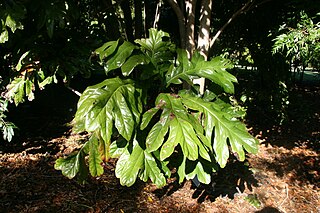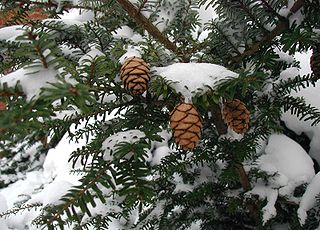
Garcinia is a genus of flowering plants in the family Clusiaceae native to Asia, America, Australia, tropical and southern Africa, and Polynesia. The number of species is disputed; Plants of the World Online (POWO) recognise up to 400. Commonly, the plants in this genus are called saptrees, mangosteens, or garcinias, and is one of several plants known as by the name "monkey fruit".

Coccoloba diversifolia, known as pigeonplum or tietongue, is a species of the genus Coccoloba native to coastal areas of the Caribbean, Central America, southern Mexico, southern Florida and the Bahamas.

Leucaena is a genus of flowering plants in the mimosoid clade of the subfamily Caesalpinioideae of the family Fabaceae. It contains about 24 species of trees and shrubs, which are commonly known as leadtrees. They are native to the Americas, ranging from Texas in the United States south to Peru. The generic name is derived from the Greek word λευκός (leukos), meaning "white," referring to the flowers.

Athertonia is a monotypic genus of plants in the family Proteaceae. The sole described species is Athertonia diversifolia, commonly known as Atherton oak, athertonia, creamy silky oak or white oak. It is endemic to a small part of the Wet Tropics of Queensland, Australia. A relative of the macadamia, it has potential in horticulture and the bushfood industry.

Tsuga diversifolia, commonly known as northern Japanese hemlock, is a species of conifer native to the Japanese islands of Honshū, Kyūshū, and Shikoku. In Europe and North America, the species is sometimes employed as tree for the garden and has been in cultivation since 1861.

Pulicaria aromatica is a species of flowering plant in the family Asteraceae. It is found only on the island of Socotra in Yemen. Its natural habitats are subtropical or tropical dry forests and rocky areas.

Pulicaria is a genus of flowering plant in the sunflower family, native to Europe, Asia, and Africa. In North America Pulicaria is known by the common name false fleabane.
Pulicaria dioscorides is a species of flowering plant in the family Asteraceae. It is found only on the island of Socotra in Yemen. Its natural habitat is rocky areas.
Pulicaria elegans is a species of flowering plant in the family Asteraceae. It is found only on the island of Socotra in Yemen. Its natural habitats are subtropical or tropical dry forests and subtropical or tropical dry shrubland.
Pulicaria lanata is a species of flowering plant in the family Asteraceae. It is found only on the island of Socotra in Yemen. Its natural habitat is subtropical or tropical dry shrubland.

Pulicaria stephanocarpa is a species of flowering plant in the family Asteraceae. It is endemic to Yemen's Socotra archipelago, where it is native to the islands of Socotra, Samhah, and Abd al Kuri. Its natural habitats are subtropical or tropical dry shrubland and rocky areas.

Pulicaria vieraeoides is a species of flowering plant in the family Asteraceae. It is endemic to the island of Socotra in Yemen. Its natural habitat is subtropical or tropical dry shrubland.
Garcinia diversifolia is a species of flowering plant in the family Clusiaceae. It is a tree endemic to Peninsular Malaysia.
Mesosphaerum diversifolium is a species of flowering plant in the family Lamiaceae, formerly known as Hyptis diversifolia. Its natural habitat is subtropical or tropical moist montane forests only in Ecuador.

Comarostaphylis diversifolia, known by the common names summer holly and California comarostaphylos, is a species of shrub in the heath family.

Pulicaria dysenterica, the common fleabane, or, in North America, meadow false fleabane, is a species of fleabane in the family Asteraceae. It is native to Europe and western Asia where it grows in a variety of habitats ranging from semi-arid Mediterranean woodlands to wetter situations. Pulicaria dysenterica is perennial and can form dense clusters of plants, spreading by its roots. It flowers at its maximum height of about 60 centimetres (2.0 ft). Leaves are alternately arranged and clasp the stem, which itself contains a salty-astringent liquid. The yellow inflorescences are typically composed of a prominent centre of 40–100 disc florets surrounded by 20–30 narrow, pistillate ray florets. When setting seed the flower heads reflex.

Grevillea diversifolia, the variable-leaved grevillea, is a species of flowering plant in the family Proteaceae and is endemic to the south-west of Western Australia. It is an erect to prostrate shrub with simple or divided leaves and groups white to cream-coloured flowers with a dull red style.

Cissus subaphylla is a low shrub in the grape family Vitaceae. It is endemic to the Yemeni island of Socotra. The plant grows mainly in dry, low-lying areas on alluvial fans or on limestone slopes, and is rarely found above elevations of 300 metres (980 ft), where it is replaced by C. hamaderohensis. It does not have the climbing habit of other Cissus species, and its stems are flattened and gray-green in colour, with relatively small leaves and flowers. The tangled mats of C. subaphylla stems act as a protective covering for plants regularly eaten by goats and other browsing animals; the plant is thus important in the rehabilitation of species such as Dendrosicyos, Maerua and Commiphora.

Eucalyptus diversifolia, commonly known as the soap mallee, coastal white mallee, South Australian coastal mallee, or coast gum is a species of mallee that is endemic to an area along the southern coast of Australia. It has smooth bark, lance-shaped adult leaves, flower buds in groups of between seven and eleven, white to creamy yellow flowers and cup-shaped fruit.














